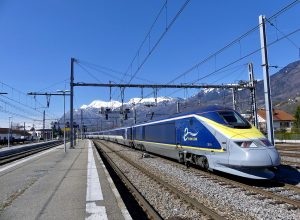Introduction:
The Class 373, also known as the Eurostar e300, stands as an epitome of high-speed rail travel, redefining the landscape of transportation across Europe. Launched in the early 1990s, this iconic train has become synonymous with efficiency, speed, and comfort, revolutionizing the way people traverse the continent. In this article, we will delve into the key features, history, and impact of the Class 373 on the realm of high-speed rail.

A Brief History:
The inception of the Class 373 can be traced back to the collaboration between French and British engineers in the late 1980s. The goal was to create a revolutionary train that could connect London and Paris through the Channel Tunnel efficiently. The result was the Eurostar e300, a high-speed electric multiple unit (EMU) train that became operational in 1994.
Key Features:
1. Speed and Efficiency: The Class 373 boasts an impressive top speed of 186 mph (300 km/h), making it one of the fastest trains in the world. This remarkable velocity significantly reduced travel time between major European cities, fostering economic and cultural exchanges.
- Channel Tunnel Capabilities: A standout feature of the Class 373 is its ability to traverse the Channel Tunnel, a 31.4-mile (50.5 km) underwater rail tunnel connecting the United Kingdom and France. This not only made the train a symbol of European integration but also opened up new possibilities for seamless cross-border travel.
- Comfort and Amenities: The interior of the Class 373 is designed with passenger comfort in mind. Spacious seating, large windows, and a quiet environment contribute to an enjoyable travel experience. Additionally, onboard amenities, including dining options and Wi-Fi connectivity, cater to the modern traveler’s needs.
- Environmental Considerations: With a focus on sustainability, the Class 373 represents a greener mode of transportation compared to traditional methods. Electric propulsion minimizes carbon emissions, aligning with contemporary efforts to reduce the environmental impact of travel.
Impact on European Travel:
- Reduced Travel Times: The introduction of the Class 373 significantly slashed travel times between major European cities. The London to Paris journey, for instance, was reduced to just over two hours, enhancing business and tourism opportunities between the two capitals.
- Economic Integration: The Class 373 played a pivotal role in promoting economic integration across Europe. The seamless connectivity it provided encouraged businesses to expand their reach and facilitated efficient cross-border trade, contributing to the economic development of the continent.
- Cultural Exchange: By bringing cities closer together, the Class 373 facilitated cultural exchange among European nations. People could now easily explore diverse cultures, fostering a sense of unity and understanding across borders.
- Tourism Boost: The ease of travel afforded by the Class 373 contributed to a significant boost in tourism. Iconic landmarks and cultural attractions became more accessible, attracting visitors from different corners of the continent and beyond.
© Phill Richards via Wikimedia Commons
Conclusion:
The Class 373, with its remarkable speed, efficiency, and contributions to economic and cultural integration, has left an indelible mark on the landscape of European high-speed rail travel. As a symbol of progress and connectivity, this iconic train continues to be celebrated for its role in shaping a new era of transportation, bringing people together and redefining the possibilities of cross-border mobility.







